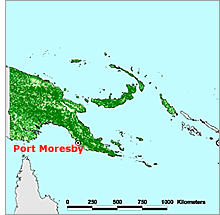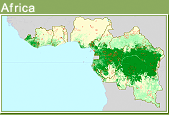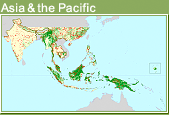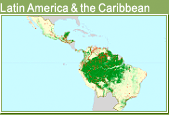Country details
Status of Tropical Forest Management 2005
Asia & the Pacific
Papua New Guinea

©UNEP-WCMC 2004
Two-thirds of PNG is under forest cover and the official timber harvest is well below the estimated national sustainable timber yield. On average, each citizen has rights over about 6.4 hectares of forest. However, the majority of people still live in extreme poverty. The challenges are substantial if SFM is to be achieved. Key among them would appear to be: reducing the social and cultural disruption of logging; increasing the benefits to local development of forest management; and increasing the allocation of resources to the monitoring of logging activities and the implementation of forest policies at the national level.
Key points
- Customary land ownership is guaranteed by the PNG constitution and is the key factor influencing the use of the forests; 97% of the land is held as communal or clan commons.
- The determination of a PFE is difficult in PNG given its land-tenure system. Nevertheless, ITTO estimates that the country has about 10.5 million hectares of forest that might be considered permanent; these include 8.7 million hectares of forest over which timber rights have been acquired (production PFE), 1.7 million hectares allocated for protection and about 80,000 hectares of timber plantations.
- At least 1.5 million hectares of natural-forest production PFE are estimated to be managed sustainably. No estimate could be made of the extent to which the protection PFE is so managed.
- The PNG Forest Authority was established in 1991 by the Forestry Act as a statutory corporation with regulatory and administrative responsibility for the management of the country's forests.
- A 'landowner company' concept was developed as part of the 1979 national forest policy in order to increase national participation in forestry. However, this has not been wholly successful.
- PNG is a major exporter of tropical logs, shipping out an estimated 2.02 million m3in 2003 to China, Japan and other mostly Asian destinations.
- The government collects revenues from a log export tax and a reforestation levy, while resource owners receive a royalty on timber harvested (10 kina per m3) and other levies and premiums.
- Customary landowners participate in the processes by which the Forest Authority purchases timber rights but are not much involved in the subsequent management and development of the resources.

 Africa
Africa  Asia & the Pacific
Asia & the Pacific  Latin America & the Caribbean
Latin America & the Caribbean